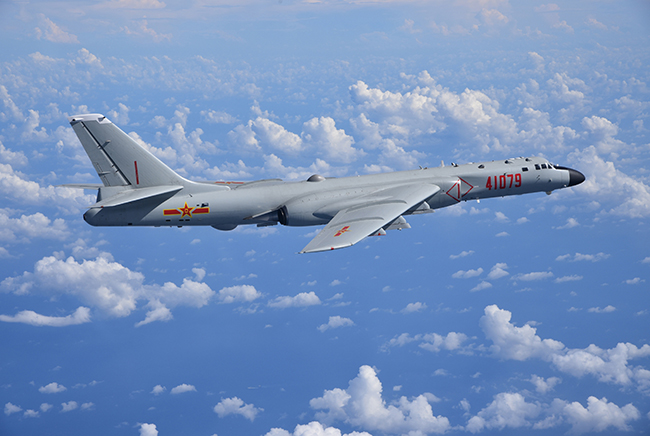
An H-6K bomber flies in the airspace over the South China Sea on March 27, 2018. Twelve H-6K bombers assigned to a division of the PLA Air Force recently conducted a long haul flight from the hinterland of China's central Shaanxi Plain to a certain area to carry out military training, according to the official social media account of the Chinese PLA Air Force on the Sina Weibo, a Chinese microblogging site. Chinese Ministry of National Defense photo by Wang Guosong.
At least two decades of a “very aggressive modernization effort” has brought China’s military to the cusp of a nuclear triad for the first time, along with dramatic progress in developing hypersonic missiles and an air force with a long-range power projection capability, the Pentagon warns in a new report on that country’s military power.
While there has been large-scale progress in “niche” capabilities that have created “areas of excellence,” particularly in ballistic and cruise missiles, a lack of training and a shortfall in integrated command and control is still holding the country back, said Randall Schriver, the assistant secretary of defense for Indo-Pacific security affairs, in a Friday briefing.
“This is a national effort, that’s resourced very well and it’s targeted at them being … the pre-eminent power in the Indo-Pacific,” Schriver said.
The 136-page report to Congress states China has used economic, foreign policy, and security tools “to realize this vision,” with a special focus on replacing imported technology with domestically produced technology.
MOVING TOWARD A TRIAD
The report states that China is pursuing a viable nuclear triad through the development of a nuclear-capable air-launched ballistic missile to be carried on advanced bombers, and the development of new Jin-class submarines.
“The [People’s Liberation Army] is upgrading its aircraft with two new air-launched ballistic missiles, one of which may include a nuclear payload,” the report states. “Its deployment and integration would, for the first time, provide China with a viable nuclear ‘triad’ of delivery systems dispersed across land, sea, and air forces.”
While the CJ-20 missile is in development, the Pentagon is reticent to say it is operationally capable. The same goes for the nuclear ballistic missile capability of the Jin-class submarine.
“We’re tracking what they’re doing,” Schriver said. “… Without getting specific on the timeline, they’re heading that direction, … toward having capable delivery systems in those three domains.”
The technology may not be fully operational, and the training and doctrine are also holding China back from having an operational triad, though it is “certainly something they are heading toward,” Schriver said.
In addition to the development of the nuclear capability of bombers and submarines, China also already has 90 ground-based intercontinental ballistic missiles, the report states.
ADVANCEMENTS IN THE AIR
China’s air force is undertaking a concerted effort to establish a “long-range power projection capability,” with leadership pressing for a “truly ‘strategic’ air force,” the report states.
The air force has 2,700 total aircraft, 2,000 of which are combat aircraft. There are about 600 fighter aircraft, most of which are fourth-generation fighters. There has been progress in developing the fifth-generation FC-31 and J-20 aircraft, including a recent demonstration of both the J-20 in November. China is also importing advanced Su-35 fighters from Russia.
The country’s aviation industry is also advancing, through initial deliveries of the Y-20 large transport aircraft and completion of the world’s largest seaplane, the AG600, the report states. China is modernizing its unmanned aircraft fleets with domestically produced drones.
China also has one of the world’s largest air and missile defense systems, with a combination of Russian-made and Chinese-made missiles. The country has contracted for the Russian-made S-400 as a follow on to its SA-20 and CSA-9 systems, with the first test fires of the new system in December, the report states.
Last August, China successfully tested its hypersonic glide vehicle, the XINGKONG-2, that it publicly said is a hypersonic waverider vehicle. This is “something we’re concerned about,” Schriver said, noting the Pentagon’s budget request calls for both defensive capabilities to counter this and significant investment in offensive capabilities for the US, Schriver said.
Most of the technology development is dependent on the country’s aggressive use of cyber, along with acquiring foreign technology.
“China uses a variety of methods to acquire foreign military and dual-use technologies, including targeted foreign direct investment, cyber theft, and exploitation of private Chinese nationals’ access to these technologies, as well as harnessing its intelligence services, computer intrusions, and other illicit approaches,” the report states.
In 2018, China used these efforts to acquire “sensitive, dual-use, or military-grade equipment from the United States, [which] included dynamic random access memory, aviation technologies, and anti-submarine warfare technologies,” the report states.
While Chinese efforts in the cyber realm has stayed steady in recent years, the US military has grown more aware of this and increased its defensive capability, Schriver said.
REACH INTO THE ARCTIC
This year’s report includes a special section devoted to China’s increased focus on the Arctic. In January 2018, China published a strategy on creating a “Polar Silk Road” and has called itself a “Near-Arctic State.”
Their focus has publicly been on natural resources and sea lines of communication, and China has become an observer on the international Arctic Council. The country has deployed icebreakers and research stations to Iceland and Norway.
Countries in the Arctic region have questioned China’s reach into the area, including Denmark, which has expressed concern with China’s interest in Greenland. Civilian research in the region “could support a strengthened Chinese military presence,” the report states.
There’s “a lot of ambition,” which is likely “multi-faceted in terms of their objectives,” Schriver said. While this includes their stated objectives, the arctic could also provide a “safe harbor for strategic assets such as ballistic missile carrying subs,” he said. This is a “possibility that, in the future, we will watch closely.”